I began to describe the steps required to grow Japanese black pine bonsai from seed last year, but left off just after planting the seeds. I ended up abandoning last year’s batch as only a dozen seeds sprouted. I tried again this year with much better luck. Due to a cold spring, the seeds took a long time to sprout. After maybe three months, most of the seeds I’d planted were growing well. It was time to make seedling cuttings.
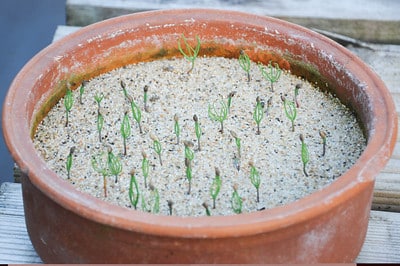
Young pine seedlings
Pine seedlings typically produce a single tap root that reaches downward and grows vigorously to provide a good anchor for the tree. Although they are good for forest trees, tap roots are not as good for young bonsai.
A couple of generations ago, bonsai enthusiasts figured out that cutting the tap root produced a number of lateral roots. As these lateral roots developed, the young trees grew faster, denser, and produced a flared trunk base that is often desired in pine bonsai. Many pine bonsai have been produced in Japan by this technique, and the technique has been gaining popularity in the US for at least 20 years. I first learned about the process from Boon Manakitivipart and Bonsai Today numbers 12 and 20. The techniques below represent knowledge I’ve picked up from Boon, Bonsai Today, and many years of practice – I started my first batch of pine seedlings over 17 years ago.
The basics of the process are simple: make cuttings out of young pine seedlings. I begin by filling a nursery flat with 4″ plastic pots and adding the soil, one layer at a time.
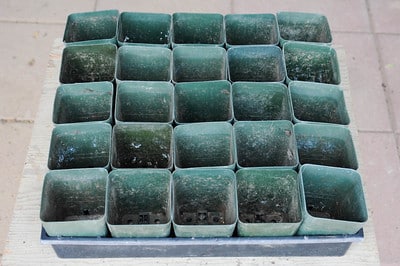
25 pots in a flat
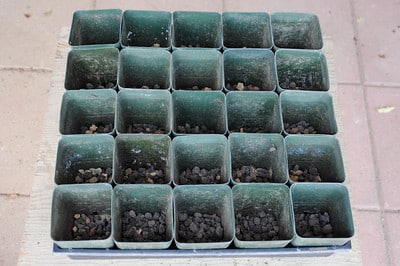
Drainage – large lava particles
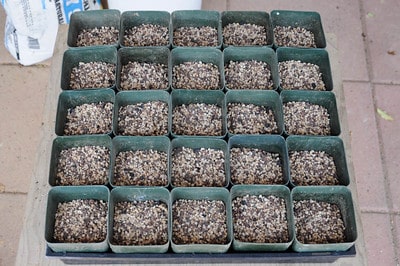
Standard Boon mix – akadama, pumice, and lava
I will plant the pines in a pocket of sand to keep the cuttings moist. I watered the soil and then used the handle of a bonsai trowel to create craters into which I poured fine sand.
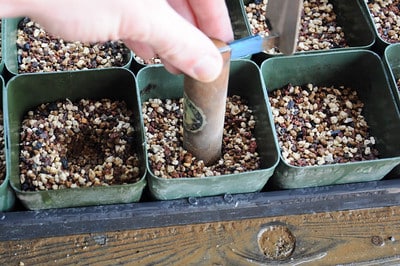
Repurposing a bonsai trowel
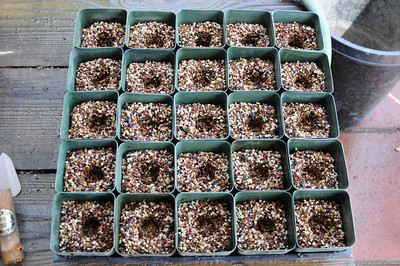
Craters created
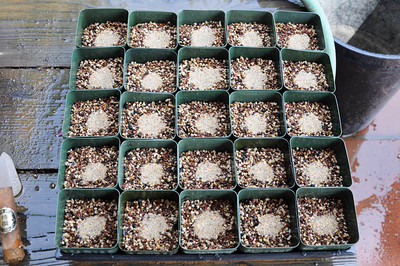
Craters filled with sand
Once the sand was in place, I again watered the soil and created small holes with large gauge copper wire. When the cuttings are ready, I’ll carefully drop them in these holes.
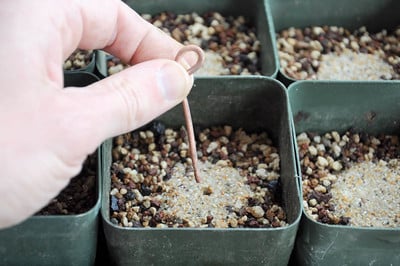
Creating space for the cuttings
The next step is creating the cuttings. I begin by carefully uprooting one cutting at a time. I try to use seedlings that are healthy like the one on the right in the photo below. The two seedlings on the left are weak – I did not use them for cuttings.
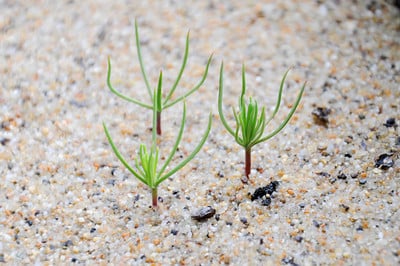
Two weak seedlings and one healthy seedling
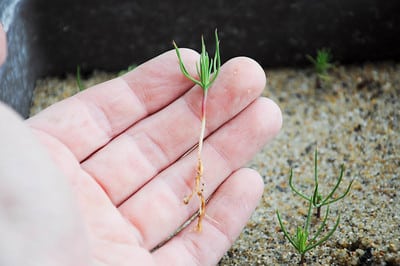
Healthy pine seedling
There was considerable variation among the uprooted seedlings. Although I typically worked with one at a time, I did a few at once for this photo.
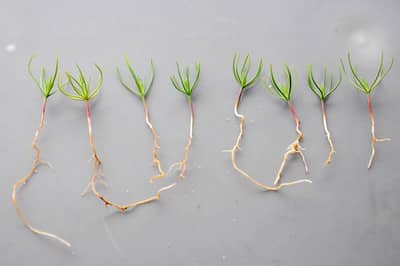
Pine seedlings – time to make the cuttings
I made the cuttings with a razor, leaving about 3/4″ of stem below the first needles. After making the cut, I quickly dropped the plants into water to keep them moist.
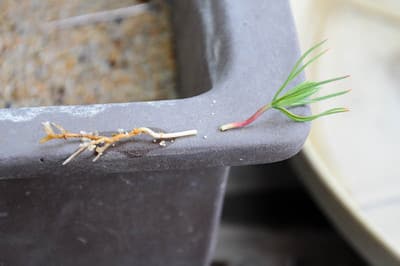
The seedling becomes a cutting
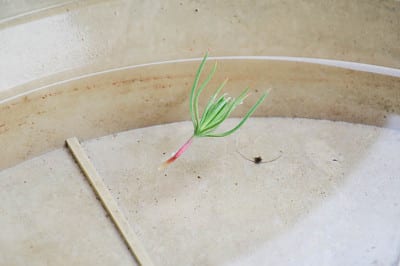
Floating around
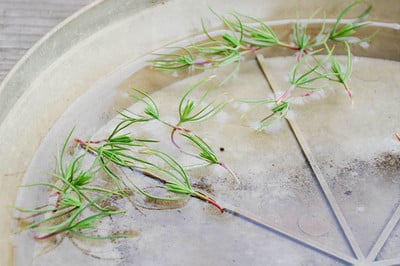
Plenty of seedling cuttings
Before planting the cuttings, I dip them in powdered root hormone to help the cuttings develop roots.
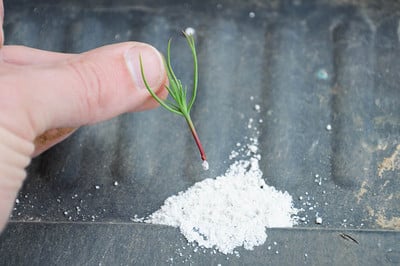
Seedling cutting with root hormone
I approach the planting of the cuttings with care. After setting the cutting in one of the holes I created, I gently pressed on the surrounding sand to close the gap. I tried to move the cutting as little as possible to avoid disturbing the hormone. I also skipped on water when I was done to avoid washing the hormone away.
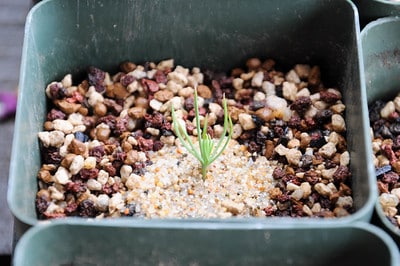
Seedling cutting in its new home
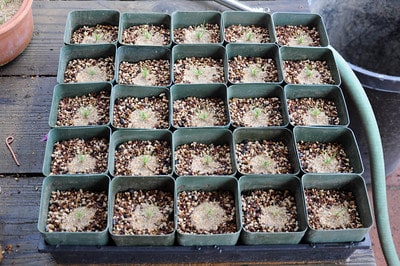
The first flat complete
I’ve kept the seedlings outside under shade cloth for the past five weeks. I’m slowly moving them into spots where they get more light, and I’m misting them several times a day – more when it’s hot, less when it’s cool out. That’s the recipe for the time being. Once the seedlings start growing quickly – evidence of new roots – I can begin to fertilize and continue to provide the seedlings with more and more light.
Subscribe to Bonsai Tonight
New Posts Delivered Every Tuesday and Friday
gaycarboys says
It’s nice to see it worked. Would you bother with seedlings though if you weren’t growing them to sell? I used to do cuttings all the time but now just prefer advanced nursery stock, It saves years in training. I am so impatient! Thanks for the post
xwires says
Alex makes really good points. I too like working with more mature trees, but I grow pines from seed because it’s so difficult to find good material. When I start a lot of trees, I am confident that I’ll end up with a few really good ones. I also know that if I don’t start trees from scratch I may never end up with good material. If I were primarily motivated by sales, I’d start a lot more!
John Kirby says
Nice sequence.
Alex V says
I believe the desire to use seedlings is that nursery stock rarely has a good nebari, which is highly prized in JBP, These trees will have nice spreading roots, and a good tree can be developed in ~10 years or so for a shohin. Really good JBP are hard to find in America, so you have to pay a lot of money, or grow your own.
Jeff Q. says
Jonas,
What is the success rate for the cuttings? I’ve heard of this method before but it is really nice to see the whole process laid out.
Thanks for the info!
jeff
xwires says
Hi Jeff – good question! I’ll be happy to share the results when they come in, likely this fall. Generally, a high percentage of the trees make it.
Jeremy says
What other mix could be used instead of Boon’s?
xwires says
Any bonsai soil mix that drains well will work with the seedlings. I’d stick with inorganic mixes with particles smaller than 1/4″.
bonsaijapan says
As always a great clear post.
Thanks,
Joe.
boon says
This is the best way to acquire good bonsai, especially pine. There are very few examples, from nursery stock, suitable for good bonsai. Even with the these examples, there are many issues that need to be corrected. The time spent fixing these problems will equal the time growing JBP from seed; the different is you have total control.
keisen says
What I always wanted to know, and explained with pictures. Thank you.
tom tynan says
Jonas..The articles you mention – suggest that the optimum time to make the cutting is when the stem of the seedling turns a violet color. Is that correct based on your experience ? Approx. how long since you planted the seeds – until you made the cutings…Tom
xwires says
Hi Tom – I don’t have enough experience to know how much difference the stem color makes when making cuttings, but I’ve noticed that by the time the center bud begins to grow – the time at which I look to make the cuttings – the stem has usually turned red or purple. As for the time from planting the seeds to making cuttings, that’s tricky. Some seeds sprouted early and grew slowly. Others sprouted late but grew quickly. About three months after planting the seeds – much later than I expected – most seedlings were growing and ready for the cutting process.
As an experiment, I made a dozen cuttings from weak or young seedlings to see what happens. I’m curious to learn what becomes of these and will share the results when I find out.
Richard says
Thank you for such a clear and concise “tutorial”. I’m intrigued and would like to give it a try myself. One question from this novice: I live on the east coast (Vermont). What would my game plan be for the seedlings during the 1st winter? Should I put them in a greenhouse (35-40 degrees) for 16 weeks with my other trees and allow them to go dormant or do they require a completely different environment?
Thank you.
xwires says
Hi Richard – I think your idea of protecting the seedlings in a greenhouse that stays above freezing is a good one, and it’s OK that the seedlings go dormant in the first winter. I think the main idea is to protect the seedlings from hard freezes.
Alexander says
Good morning! What’s with your pines? Result?
xwires says
Hi Alexander, there’s not much news to report – they’ve been growing very slowly! Now that it’s a bit warmer they’re starting to move a little – I’ll post an update once they’ve grown a bit more.